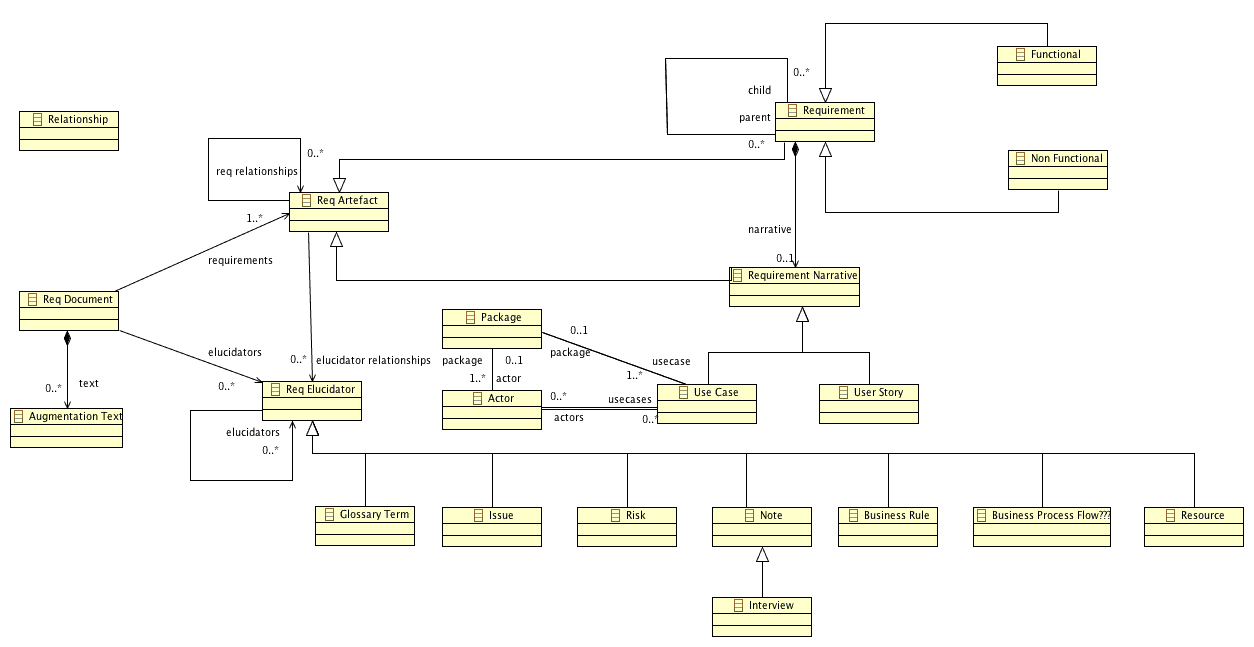Notice: this Wiki will be going read only early in 2024 and edits will no longer be possible. Please see: https://gitlab.eclipse.org/eclipsefdn/helpdesk/-/wikis/Wiki-shutdown-plan for the plan.
Difference between revisions of "Requirements Model"
| Line 8: | Line 8: | ||
<p>The figure below shows the initial high level analysis model for the ORMF requirements. At this stage the model simply reflects the main elements and their mutual relationships.</p> | <p>The figure below shows the initial high level analysis model for the ORMF requirements. At this stage the model simply reflects the main elements and their mutual relationships.</p> | ||
| − | [[Image:emf_model. | + | [[Image:emf_model.gif]] |
<p>At the highest level of abstraction we have the ''Requirement Artefact'', which represents all general features that are shared by all types of requirements. The Requirement Artefact has two specialisations, namely the ''Requirement'' and the ''Requirement Narrative'' elements.</p> | <p>At the highest level of abstraction we have the ''Requirement Artefact'', which represents all general features that are shared by all types of requirements. The Requirement Artefact has two specialisations, namely the ''Requirement'' and the ''Requirement Narrative'' elements.</p> | ||
Revision as of 07:57, 25 December 2008
< To: ORMF
Introduction
This page describes the new requirements model, which is now based on the EMF framework. The model is currently defined only at a high level and will iteratively refine over the course of the next few weeks.
The high level view of the model
The figure below shows the initial high level analysis model for the ORMF requirements. At this stage the model simply reflects the main elements and their mutual relationships.
At the highest level of abstraction we have the Requirement Artefact, which represents all general features that are shared by all types of requirements. The Requirement Artefact has two specialisations, namely the Requirement and the Requirement Narrative elements.
The Requirement element represents standard requirements, which can then be further specialised into Functional Requirements or Non Functional Requirements. Requirements may be specified by other Requirements, in a parent/child relationship.
Requirement Narrative elements are types of Requirements Artefacts that expect descriptive elements, such as flows of events. A Requirement may be associated with (and traceable to) a Requirement Narrative element. Special cases of Requirement Narratives are User Story and Use Case elements. A Use Case element in particular may have associations with (refer to) a number of Actor elements and zero or one Use Case Package element.
Any Requirement Artefact element may then contain a number of relationships to Requirement Elucidator elements. Requirement Elucidators are elements that may be utilised across a number of different types of Requirement Artefacts and that permeate the entire requirements model. Examples of Requirements Elucidators are Issues, Glossary Terms and Notes. The distinguishing features of Requirements Elucidator elements are a) the fact that each Elucidator may be referred to by multiple Requirements Artefacts (f.i. a Note may be related to, or elucidate, any number of Requirements Artefacts) and b) the fact that it is possible to compile lists of all Elucidators of a given type defined across the entire requirements model through generic reporting tools.
The model shows all the types of Requirement Elucidators we intend to support.
Any Requirement Artefact element is characterised by relationships with either other Requirement Artefacts (named “requirement relationships” in the model) or Requirement Elucidators (named “elucidator relationships” in the model). These relationships have many features in common, such as their stereotype, which defines the type of Requirement Artefact or Requirement Elucidator that is referred to as the target of the association, or their multiplicity. As such, these associations could be described by a common association class, generically called Relationship. The problem with doing this is that EMF does not support association classes. This is the reason why the Relationship element shown in the model is currently sitting in a corner as a simple reminder.
The model finally defines two other types of elements, namely Requirement Document and Augmentation Text.
A Requirement Document represents a textual artefacts that acts as a “wrapper” around specific sub sets of Requirement Artefacts. A good example of this type of element is the Software Requirements Specification document, which is typically a high level survey of all functional, non functional and use case related requirements for a software project or for a specific component of the project. The analyst typically organises the survey in a particular way, that needs to be reproducible through the natural evolution of the requirements and that needs to contain sections of descriptive text that acts as a cohesive agent for all requirement artefacts proper. Examples of such sections are introduction, overview of the problem domain etc. This text is what the model refers to as Augmentation Text, which is represented as a separate model element; any Requirement Document makes use of an arbitrary number of Augmentation Text elements.
Current questions
- How to represent the association class Relationship in EMF?
Any suggestions or comments regarding this requirements model are warmly welcome.

